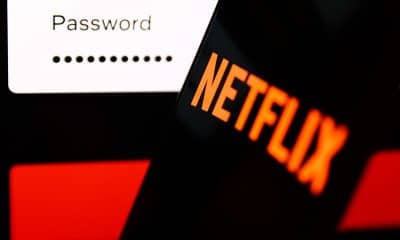Business
Netflix’s Recipe For Success Includes ‘Secret Sauce’ Spiced With Silicon Valley Savvy

Los Gatos, California – Although its video streaming service has a Hollywood shine, Netflix continues to draw on its Silicon Valley roots to remain ahead of traditional TV and movie studios.
The Los Gatos, California-based business, which is more than 300 miles from Hollywood, frequently uses its technological toolkit without viewers’ knowledge. It frequently employs tiny twists on the knobs of viewer suggestions to keep its 270 million global members satisfied at a time when most of its streaming competitors are experiencing waves of cancellations from inflation-weary customers.
Even when hit TV shows like “The Crown” or “Bridgerton” are popular, Netflix strives to cater to its diverse audience. One component of that mix is adapting summaries and trailers for its diverse lineup of episodes to each viewer’s interests.
Netflix AP News Image
Netflix’s Recipe For Success Includes ‘Secret Sauce’ Spiced With Silicon Valley Savvy
Someone who enjoys romance may watch a story summary or video trailer for “The Crown” that focuses on Princess Diana and Charles’ relationship, but another viewer interested in political intrigue may see a clip of Queen Elizabeth meeting with Margaret Thatcher.
For an Oscar-nominated film like “Nyad,” an action fan may see a trailer of the titular character immersed in water during one of her heroic swims, but a comedy fan may see a lighthearted clip containing some hilarious banter between Annette Bening and Jodie Foster.
Netflix can pull off these variations because it thoroughly understands viewing habits gleaned from crunching data from subscribers’ histories with its service, including those of customers who signed up in the late 1990s when the company launched a DVD-by-mail service that lasted until last September.
“It is a secret sauce for us, no doubt,” Eunice Kim, Netflix’s chief product officer, said when outlining the complexities of how the company tries to entice different consumers to watch various episodes. “The North Star we have every day is keep people engaged, but also make sure they are incredibly satisfied with their viewing experiences.”
As part of that effort, Netflix is redesigning the home page users see when they watch the streaming service on a television. The improvements are intended to package all of the information that may appeal to a subscriber’s preferences more compactly, reducing “gymnastics with their eyes,” according to Patrick Flemming, Netflix’s senior director of member products.
What Netflix is doing with its previews may appear insignificant, but it can have a significant impact, especially if customers trying to save money begin to reduce the number of streaming services they use.
According to data compiled by the research firm Antenna, video streaming services experienced approximately 140 million account cancellations last year, a 35% increase from 2022 and nearly tripling the volume in 2020, when the COVID-19 pandemic created a surge in demand for entertainment from people confined to their homes.
Netflix does not divulge its cancelation or churn rate, but its streaming service added 30 million subscribers last year, the second-largest annual rise after its surge during the 2020 pandemic lockdowns.
A crackdown on viewers who were freeloading off Netflix customers and sharing their account credentials contributed to last year’s subscription surge. According to J. Christopher Hamilton, an assistant professor of television, radio, and film at Syracuse University, the corporation also benefits from technological know-how, which allows it to continue funneling shows to clients who enjoy them and believe the service is worth the money.
Netflix AP News Image
Netflix’s Recipe For Success Includes ‘Secret Sauce’ Spiced With Silicon Valley Savvy
“What they have been doing is pretty ingenious and very, very strategic,” Hamilton stated. “They are definitely ahead of the legacy media companies who are trying to do some of the same things but just don’t have the level of sophistication, experience nor the history of the data in their archives.”
Netflix’s nerdy roots were originally derided by an entertainment industry that looked down on the company’s geekiness.
“It’s a little bit like, is the Albanian army going to take over the world?” former Time Warner CEO Jeff Bewkes remarked of Netflix in a 2010 interview about the threat it represented.
Not long after that rebuke, Netflix began mining its viewing data to figure out how to create a slate of original programming that would attract more subscribers — an ambitious expansion that forced Time Warner (now merged into Warner Bros. Discovery) and other long-established entertainment companies such as Walt Disney Co. to scramble to build their streaming services.
Although those expansions initially drew many customers, they also resulted in significant losses, prompting management changes and harsh cuts, including the abrupt termination of a CNN streaming service.
Netflix’s use of technology to retain members and raise its profits—the company’s profit increased 20% to $5.4 billion last year—is now widening the gap with competing providers still struggling to cut losses.
Disney’s four-year-old streaming service just became profitable following an overhaul managed by CEO Bob Iger, but he believes more effort is needed to catch up with Netflix.
“We need to be at their level in terms of technology capability,” Iger stated at a conference earlier this year. “We’re now in the process of creating and developing all of that technology, and obviously the gold standard there is Netflix.”
Netflix | AP News Image
Netflix’s Recipe For Success Includes ‘Secret Sauce’ Spiced With Silicon Valley Savvy
Netflix isn’t going to help its competitors by revealing its secrets, but the slicing and dicing typically begins with determining which viewers gravitate to specific genres — the broad categories include action, adventure, anime, fantasy, drama, horror, comedy, romance, and documentary — and then delving deeper from there.
In other cases, Netflix’s algorithms will attempt to predict a viewer’s mood at any particular time by evaluating which titles are browsed or clicked on. In other cases, technology can easily determine how to make a film or television series as appealing to specific viewers as feasible. If Netflix’s data shows that a subscriber has viewed a lot of Hindi productions, it would almost be a no-brainer to show footage of Bollywood star Alia Bhatt in a role she performed in the American film “Heart of Stone” rather than the film’s lead actress, Gal Gadot.
“We want to do a really good job putting the things that you prefer in front of you,” Kim stated. “Part of that is the content recommendations themselves, but it’s also about how we present the content to you.”
SOURCE – (AP)









































